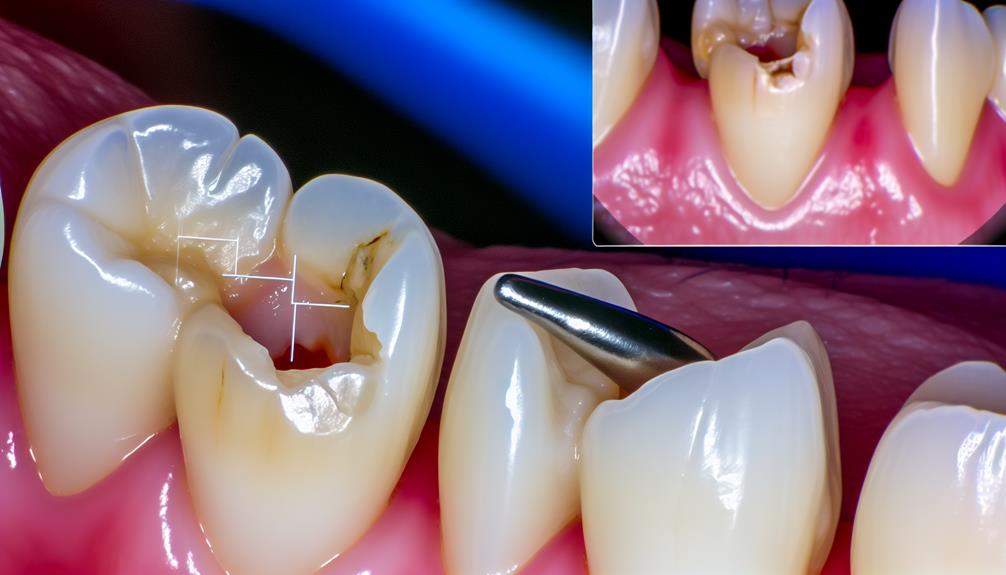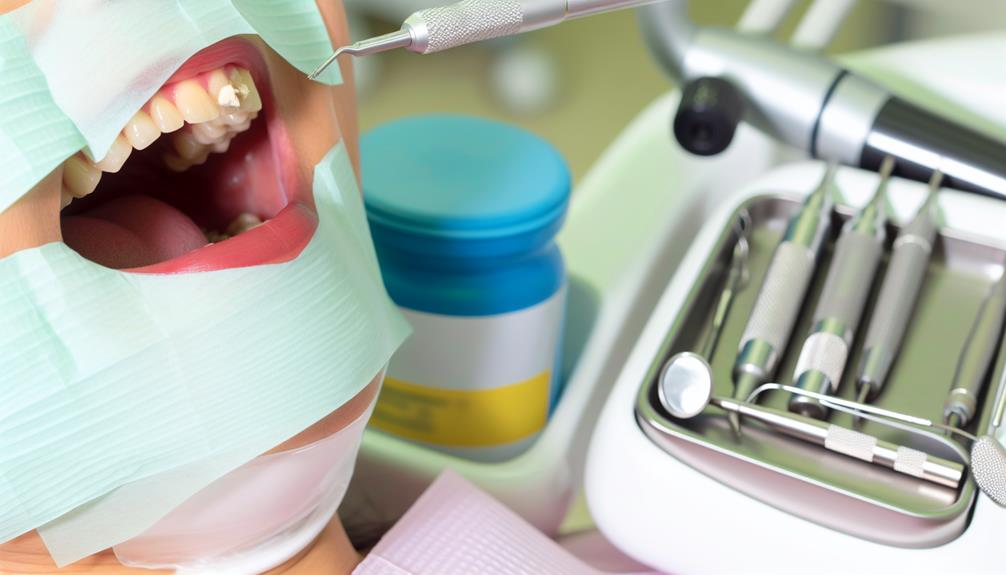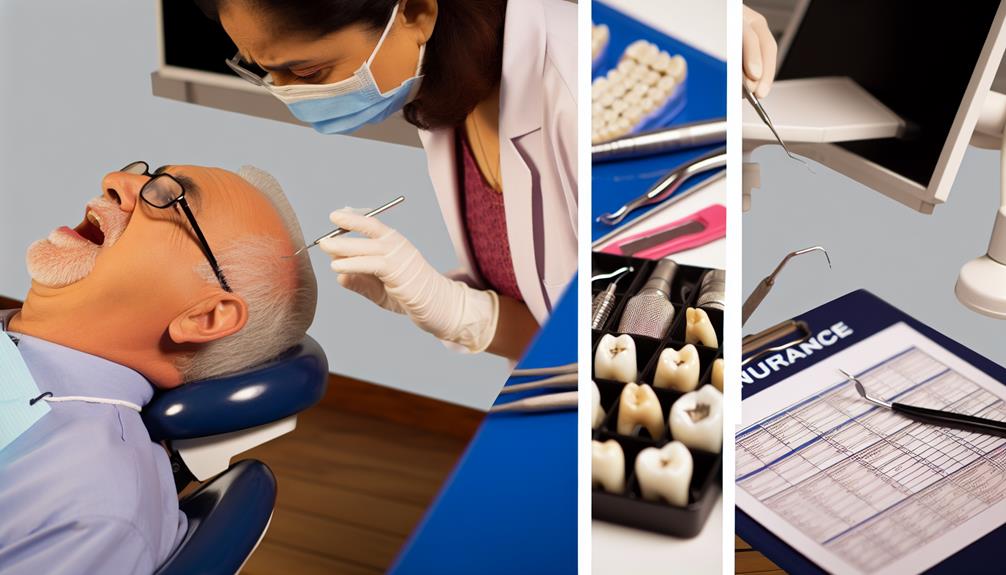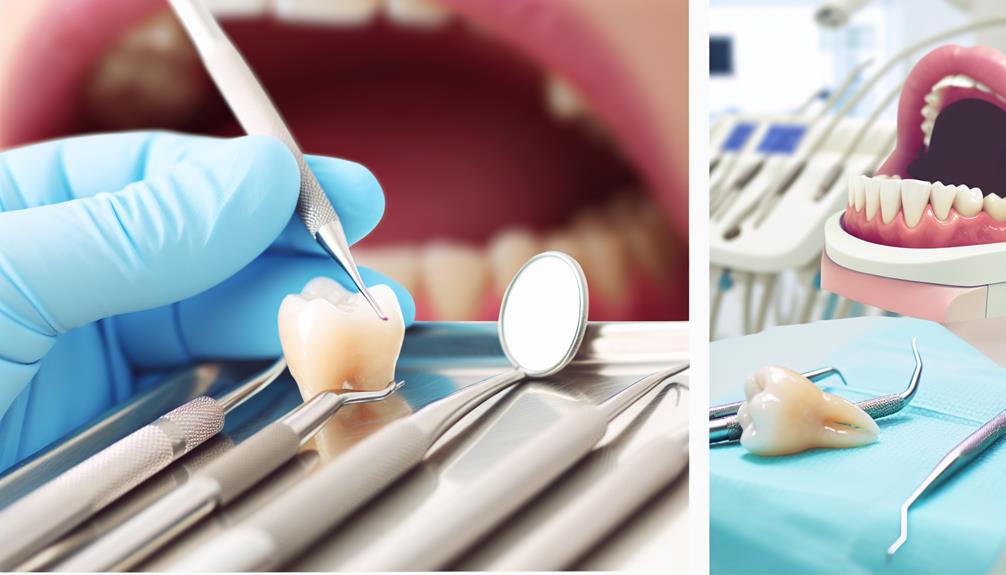Repairing a chipped tooth can vary in cost based on the severity of the damage. Minor chips may only require cosmetic bonding, costing between $100 and $600, while severe fractures might necessitate crowns or root canals, priced at $800 to $3,000. Insurance coverage can differ, so it is important to review your plan to understand what is included. Financing options such as payment plans or dental loans can alleviate immediate financial burdens. Furthermore, preventive measures are vital for maintaining dental health. There's more to explore regarding treatment options and financial resources to help you navigate this situation effectively.
Key Takeaways
- Repair costs for chipped teeth vary, with dental bonding ranging from $100 to $600, while crowns can cost between $800 and $3,000.
- Insurance coverage for repairs differs by plan; some may cover portions of treatment, while others may exclude cosmetic restorations.
- Financing options like payment plans, dental loans, and Health Savings Accounts can ease the financial burden of dental repairs.
- Preventive care, including good oral hygiene and the use of mouthguards, can help minimize the risk of tooth chips.
- Seek dental attention for severe pain, visible fractures, or increased sensitivity, which may indicate the need for restorative treatment.
Types of Tooth Chips

Chipped teeth can manifest in various forms, each requiring distinct approaches to treatment. The most common types of chips include minor enamel fractures, which may not affect tooth structure or function but can present significant cosmetic concerns. These minor chips often result in emotional impact, as individuals may feel self-conscious about their appearance. Chronic stress can exacerbate these feelings, potentially weakening the immune system and making it harder for the body to heal after dental procedures how stress impacts health.
Moderate chips, which extend into the dentin layer, typically necessitate more thorough intervention, such as dental bonding or porcelain veneers. These treatments not only restore the tooth's function but also address the aesthetic aspects, which are vital for many patients seeking to regain their confidence.
Severe chips, characterized by significant loss of tooth structure or exposure of the pulp, may require crowns or root canal therapy. The emotional toll of such injuries can be profound, as they may lead to anxiety about dental health and self-image.
Understanding the different types of chips is essential for both patients and dental professionals. By recognizing the specific nature of the damage, tailored treatment plans can be developed, ensuring that both the cosmetic concerns and emotional impacts are effectively addressed. This collaborative approach fosters a sense of belonging and support for individuals traversing their dental health journey.
Symptoms and Diagnosis
Identifying the symptoms associated with a chipped tooth is essential for timely intervention. Common signs may include sensitivity to temperature, discomfort while chewing, or visible damage to the tooth structure. It's important to recognize that emotional distress from dental issues can also affect overall well-being, similar to how grief can impact individuals effective strategies for healing. A thorough diagnostic evaluation, often involving visual inspection and possibly radiographic imaging, will help determine the extent of the damage and guide appropriate treatment options.
Common Symptoms to Watch
A chipped tooth can present various symptoms that warrant attention to guarantee proper diagnosis and treatment. One of the most common signs is increased tooth sensitivity, which may manifest as discomfort or pain when consuming hot, cold, or sweet foods. This sensitivity often indicates that the protective enamel has been compromised, exposing the underlying dentin and nerves.
In addition to sensitivity, you might notice visible chips or fractures on the tooth surface. These can range from minor imperfections to significant breaks that affect the tooth's structure. If you experience discomfort while chewing, this may also signal an issue with the stability of the tooth, making it vital to seek professional evaluation.
Maintaining good dental hygiene is essential, especially after experiencing a chipped tooth. Regular brushing and flossing can help prevent further damage and minimize the risk of infection. If you notice any of these symptoms, it's important to consult a dental professional promptly. Taking action not only preserves your oral health but also supports your overall well-being, fostering a sense of community and care among those who share similar dental concerns.
Diagnostic Procedures Explained
When experiencing symptoms such as increased sensitivity or visible chips, a detailed diagnostic evaluation becomes essential to ascertain the extent of damage and guide appropriate treatment. Dental examinations serve as the foundation for this process, allowing dentists to assess the tooth's condition thoroughly. During these examinations, practitioners will often conduct a visual inspection, coupled with palpation, to identify any underlying issues that may not be immediately apparent.
In many cases, diagnostic imaging is employed to obtain a clearer view of the tooth's structure and surrounding tissues. X-rays can reveal fractures or decay that are not visible during a standard examination. This information is vital for determining whether a simple repair, such as bonding or a filling, is sufficient, or if more extensive procedures, like crowns or root canals, are necessary.
Ultimately, understanding the diagnostic procedures involved can foster a sense of belonging and reassurance among patients, as they realize the importance of individualized care tailored to their unique dental needs. Addressing concerns early through proper diagnosis not only alleviates discomfort but also enhances long-term oral health outcomes.
Repair Options Available

Various repair options are available for addressing a chipped tooth, each tailored to the extent of the damage and the patient's specific needs. For minor chips, cosmetic bonding is often the preferred method. This procedure involves applying a tooth-colored resin to the affected area, effectively restoring the tooth's shape and function. Bonding is a quick solution and can often be completed in a single visit, offering immediate results. Staying positive during this process is key, as it can be emotionally challenging navigating job changes.
In cases where the damage is more significant, dental veneers may be recommended. Veneers are thin shells of porcelain or composite resin that cover the front surface of the tooth, providing both aesthetic appeal and structural support. This option is particularly beneficial for chips that affect the appearance of the smile, as veneers can be customized to match the surrounding teeth.
Both cosmetic bonding and dental veneers are effective solutions that can help patients regain confidence in their smiles. It is essential to consult with a dental professional to determine which option aligns best with your dental health, cosmetic goals, and lifestyle. Understanding these repair options can empower you to make informed decisions regarding your dental care.
Cost Breakdown of Repairs
Understanding the cost associated with repairing a chipped tooth is essential for patients as they navigate their options. The total expense can vary markedly based on several cost factors, including the severity of the chip, the chosen repair materials, and the dentist's expertise. Below is a breakdown of some common repair methods and their approximate costs:
| Repair Method | Cost Range |
|---|---|
| Dental Bonding | $100 – $600 |
| Composite Filling | $150 – $400 |
| Porcelain Veneers | $800 – $2,500 |
| Crown Repair | $800 – $3,000 |
| Root Canal Treatment | $700 – $1,500 |
Each option presents different repair materials, which also contribute to varying costs. For instance, dental bonding uses a resin that is generally less expensive than porcelain veneers, which offer a more aesthetic solution. It is vital to discuss these factors with your dentist to align your treatment choice with your budget and aesthetic goals. Ultimately, understanding these cost components will empower patients to make informed decisions regarding their dental care.
Insurance Coverage Insights

Understanding the nuances of dental insurance is vital when addressing a chipped tooth, as coverage can vary considerably between plan types. Many policies may impose limitations on the extent of coverage for restorative procedures, which can affect out-of-pocket expenses. For example, some plans may only cover a portion of the treatment costs or require a waiting period before restorative work is eligible. It is essential for patients to review their insurance details carefully to guarantee they are fully informed of their benefits and any potential restrictions who is qualified to prescribe medication.
Types of Dental Insurance
Dental insurance plays an essential role in managing the financial aspects of oral health care, particularly for procedures such as repairing a chipped tooth. Understanding the different types of dental insurance can help you make informed decisions about your coverage options. Here are the primary categories to evaluate:
- Individual Plans: These plans are purchased directly by individuals and typically offer customizable coverage based on personal needs, allowing you to choose your benefits.
- Group Insurance: Often provided by employers, group insurance plans tend to have lower premiums due to risk pooling among members. They usually cover essential dental care, including repairs.
- Preferred Provider Organizations (PPOs): These plans provide a network of dentists, offering lower costs for services rendered within the network while allowing some flexibility to see out-of-network providers.
- Dental Health Maintenance Organizations (DHMOs): These plans focus on preventive care with lower premiums, emphasizing a primary care dentist who coordinates all treatment.
Choosing the right type of dental insurance can greatly ease the financial burden of dental procedures, helping you maintain your oral health within a supportive community.
Coverage Limitations Explained
Many individuals may not be fully aware of the coverage limitations that accompany their dental insurance plans. Understanding these constraints is vital for making informed decisions regarding dental care, particularly when it comes to repairing a chipped tooth. Coverage limitations often dictate the extent of benefits available for certain procedures, which can vary greatly from one policy to another.
For instance, many plans impose annual maximums that cap the total reimbursement available to policyholders each year. This can lead to unexpected out-of-pocket expenses, especially if multiple dental issues arise. Additionally, insurance exclusions may specify particular services or materials that are not covered, which can include high-quality cosmetic restorations that some patients prefer.
It is important for individuals to carefully review their policy documents and consult with their insurance provider to clarify any uncertainties surrounding coverage limitations. By doing so, they can better navigate their options and guarantee that they receive the necessary care without facing financial strain. Ultimately, being proactive about understanding coverage can foster a sense of belonging in the healthcare journey, empowering individuals to prioritize their dental health effectively.
Financing Options for Treatments
When facing the need for treatment due to a chipped tooth, exploring financing options can greatly ease the financial burden associated with dental care. Understanding the available avenues can help you make informed decisions that suit your budget and needs, especially when evaluating the costs involved in various treatments currency exchange tips. Here are four common financing options to evaluate:
- Payment Plans: Many dental practices offer flexible payment plans that allow you to spread the cost of treatment over several months, making it easier to manage your finances without incurring debt.
- Dental Loans: These personal loans are specifically designed for dental procedures and often come with competitive interest rates. They allow you to cover the entire cost upfront while paying it back over time.
- Health Savings Accounts (HSAs): If you have an HSA, you can use pre-tax dollars to pay for dental treatments, reducing your overall expense.
- Credit Options: Some practices partner with credit companies specializing in healthcare financing, providing options that can help bridge any financial gaps.
Preventive Care Tips

Maintaining ideal oral health is essential in preventing issues such as chipped teeth. One of the most effective strategies is to establish a consistent oral hygiene routine. Brushing twice daily with fluoride toothpaste and flossing regularly can greatly reduce the risk of dental damage. Additionally, consider using a mouthguard during high-impact sports or activities, as this can provide essential protection against trauma that may lead to chips.
Dietary habits also play an important role in oral health. Limiting the intake of sugary foods and beverages can help prevent tooth decay, which can weaken enamel and increase susceptibility to chipping. Instead, opt for a balanced diet rich in fruits, vegetables, and dairy products, as these contribute to stronger teeth and gums. Foods high in calcium and phosphorus, such as almonds, leafy greens, and yogurt, are particularly beneficial for maintaining enamel integrity.
Moreover, regular dental check-ups are critical for early detection of potential issues. Establishing a supportive relationship with your dentist can foster a sense of belonging, ensuring you have access to personalized advice and preventive care tailored to your unique needs. By prioritizing these preventive measures, you can greatly reduce the likelihood of experiencing chipped teeth.
When to See a Dentist
How can you determine if a chipped tooth requires professional intervention? Understanding when to see a dentist is essential for maintaining your oral health. Several factors can indicate the need for immediate attention, particularly following incidents that result in a chipped tooth. Here are four key signs to watch for:
- Severe Pain: Intense discomfort may indicate damage to the tooth pulp or surrounding tissues.
- Visible Fracture: If the chip is significant and affects the tooth's structure, it may require restorative treatment.
- Dental Emergency Signs: Signs such as swelling, bleeding, or difficulty in chewing can signal a more serious issue.
- Sensitivity: Increased sensitivity to hot or cold could suggest exposed dentin or nerve involvement.
Chipped tooth causes can range from accidental trauma to habitual grinding. Recognizing these signs allows you to act swiftly, preserving your dental health and alleviating potential complications. If you experience any of the above symptoms, it's imperative to consult a dental professional promptly. Prioritizing your oral health fosters a sense of community and belonging, ensuring that you receive the care you need when it matters most.
Frequently Asked Questions
Can I Repair a Chipped Tooth at Home?
Repairing a chipped tooth at home is not advisable, as professional dental intervention is vital for ideal recovery and maintaining dental hygiene. While home remedies may offer temporary relief, they cannot effectively restore the tooth's structure or prevent further damage. It is important to consult a dentist promptly to guarantee appropriate treatment and minimize complications. Prioritizing dental health fosters confidence and well-being, reinforcing the significance of seeking professional care in such situations.
How Long Do Dental Repairs for Chips Last?
The longevity of dental repairs for a chipped tooth varies based on the repair option selected. Composite resin repairs typically last between five to seven years, while porcelain veneers may provide durability for over a decade. Factors influencing chipped tooth longevity include oral hygiene, dietary habits, and the extent of the damage. Consulting with a dental professional can help determine the most suitable repair option, ensuring both aesthetic appeal and functional longevity for your smile.
Will a Chipped Tooth Worsen if Untreated?
A chipped tooth, if left untreated, can lead to significant consequences. Over time, untreated dental issues may exacerbate, resulting in increased sensitivity, decay, or even infection. The compromised structure of the tooth can lead to further damage or complications, ultimately affecting overall oral health. It is essential to address a chipped tooth promptly to prevent these potential repercussions and foster a sense of belonging in a community that values proactive dental care.
What Materials Are Used for Tooth Repair?
In addressing tooth repair, several materials are commonly utilized to restore functionality and aesthetics. Composite resin, a versatile and durable material, is frequently employed due to its ability to blend seamlessly with natural tooth color. Dental bonding, a technique involving the application of composite resin, effectively adheres to the tooth surface, providing a strong and imperceptible repair. Both methods foster a sense of belonging within the dental community, promoting healthier smiles and improved self-confidence.
Can Chips on Baby Teeth Affect Permanent Teeth?
Chips on baby teeth can indeed impact the development of permanent teeth. When baby teeth are damaged, it may affect the underlying permanent tooth's structure and eruption patterns. Additionally, premature loss of a baby tooth can lead to misalignment or spacing issues as the permanent teeth emerge. Consequently, timely intervention is essential to guarantee the health of both baby and permanent teeth, fostering a healthy dental foundation for children's future oral health.





